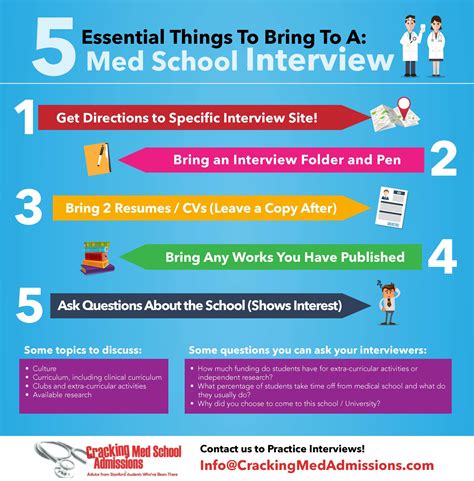Navigating the arduous process of medical school admissions involves attending numerous interviews at various institutions. While preparing for each interview thoroughly is essential, the decision-making phase after the interviews holds equal significance. Carefully considering specific factors can guide you towards the best possible choice that aligns with your aspirations and goals.

Factors to Consider When Deciding on a Medical School
After completing your interviews, it’s imperative to objectively analyze the following aspects to make an informed decision:
1. Program Strength and Curriculum
- Reputation and Rankings: Assess the school’s overall reputation and rankings in medical education and research. Consider organizations such as U.S. News & World Report and the National Science Foundation.
- Curriculum Structure: Examine the curriculum to ensure it meets your educational preferences and career aspirations. Consider factors such as the sequence of courses, clinical rotations, and research opportunities.
- Faculty and Research: Evaluate the quality and experience of the faculty and the institution’s commitment to research. This will influence the caliber of mentorship and opportunities for intellectual growth.
2. Campus Environment and Facilities
- Location and Campus Culture: Consider the location of the school and the surrounding community’s amenities and offerings. The campus culture, including student life and extracurricular activities, can significantly impact your整體體驗.
- Clinical Facilities and Resources: Assess the availability and quality of clinical facilities, including hospitals, clinics, and simulation labs. These resources play a crucial role in your clinical training and patient exposure.
- Learning Resources and Technology: Evaluate the library, technology infrastructure, and other learning resources available to students. These tools can enhance your academic experience and support your personal development.
3. Financial Considerations
- Total Cost of Attendance: Calculate the total cost of attendance, including tuition, fees, and living expenses. Consider scholarships, grants, and financial aid opportunities to offset some of the costs.
- Loan Repayment and Debt: Estimate the amount of student loan debt you may accumulate and the potential impact on your future financial obligations. Research loan repayment assistance programs and consider factors such as loan forgiveness options.
- Cost of Living: Factor in the cost of living in the area where the medical school is located. This will influence your overall financial planning and budgeting.
4. Career Prospects and Residencies
- Match Rates and Residency Placements: Research the school’s match rates and the types of residency programs its graduates typically match into. Consider whether the school’s alumni network and connections can support your career goals.
- Specialty Programs and Fellowship Opportunities: Explore theavailability of specialty programs and fellowship opportunities within the institution. These opportunities can provide specialized training and enhance your career trajectory.
- Career Services and Networking: Evaluate the school’s career services department and its effectiveness in supporting students’ career exploration, networking, and job placement.
5. Gut Feeling and Personal Fit
- First Impressions and Campus Visits: Reflect on your overall impression of the school during your interview. Consider the vibe, atmosphere, and interactions with students and faculty.
- Alignment with Values and Goals: Assess whether the school’s mission, values, and approach to medical education align with your own aspirations and goals.
- Trust Your Instincts: Ultimately, trust your instincts and make a decision that you feel comfortable with. The best medical school for you is the one where you believe you can thrive both academically and personally.
Balancing Benefits and Risks
When weighing the benefits and risks of each medical school, consider the following factors:
Benefits
- Strong academic reputation and curriculum
- Excellent clinical training opportunities
- Supportive and inclusive campus culture
- Low cost of attendance
- High match rates and residency placements
Risks
- Competitive environment with high expectations
- Limited research opportunities
- Poor location or campus amenities
- High cost of living
- Less favorable match outcomes
Comparative Analysis
To facilitate your decision-making process, create a comparative table that lists the key factors and their corresponding values for each medical school you are considering. This table will help you visualize the differences and make informed comparisons.
| Factor | Medical School A | Medical School B | Medical School C |
|---|---|---|---|
| U.S. News & World Report Ranking | 20 | 35 | 15 |
| Curriculum Structure | Traditional | Problem-Based Learning | Hybrid |
| Faculty Research Funding | $100 million | $50 million | $75 million |
| Campus Location | Urban | Suburban | Rural |
| Clinical Facilities | Large teaching hospital | Community-based clinics | Simulation lab |
| Total Cost of Attendance | $50,000 | $$45,000 | $55,000 |
| Match Rate | 95% | 90% | 85% |
| Specialty Program Availability | Cardiology, Oncology | Dermatology, Neurology | Surgery, Pediatrics |
| Campus Culture | Diverse | Competitive | Collaborative |
Additional Tips for Making a Decision
- Consolidate Your Thoughts: Take some time to reflect on your experiences and impressions of each medical school. Write down your thoughts and observations to help you clarify your priorities and goals.
- Seek Input from Others: Discuss your decision with trusted mentors, family members, or friends. Their perspectives may provide valuable insights and support.
- Visit Again: If possible, schedule another visit to the medical schools you are still considering. This will give you an opportunity to ask additional questions and further assess the campus environment and culture.
- Evaluate Your Options Carefully: Weigh the pros and cons of each medical school thoroughly before making your final decision. Consider your long-term career goals and personal preferences.
- Make an Informed Choice: The decision of which medical school to attend is a significant one. By carefully considering the factors discussed above, you can make an informed choice that will positively shape your future medical career.
Remember, the best medical school for you is the one that aligns with your individual needs, aspirations, and values. By approaching the decision-making process with a thoughtful and analytical mindset, you can confidently choose the medical school that will provide you with the best possible foundation for success.
